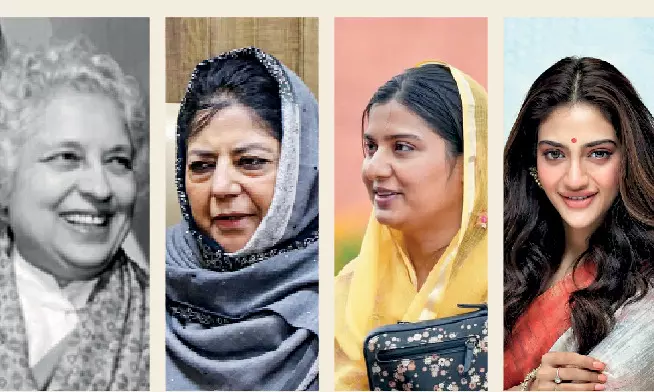Documenting Exclusion, Chronicling Courage
Rashid Kidwai and Ambar Ghosh trace the journeys of 18 Muslim women MPs, exposing systemic exclusion and chronic underrepresentation in Indian parliamentary democracy

In the foreword to Rashid Kidwai and Ambar Kumar Ghosh’s recently published book, “Missing from the House: Muslim Women in the Lok Sabha,” Shashi Tharoor writes that the book represents the first systematic attempt to chronicle the “missing” presence of Muslim women in Indian parliamentary politics. It documents the journeys of those few Muslim women who have succeeded in crossing the formidable threshold of the Indian Parliament.
Published by Juggernaut, this book narrates the plight of nearly 70 million Muslim women who have been largely excluded from the world’s largest democracy. It underscores how Muslim women continue to be positioned as outsiders in Indian politics, how their lives and journeys are affected by patriarchy, religious conservatism, and systemic exclusion.
Kidwai and Ambar place the struggle-filled trajectories of the 18 Muslim women MPs who have reached the Lok Sabha since 1952 and have played a vital role in building democracy. They have broken through countless barriers and formidable challenges to reach the Lok Sabha. Furthermore, this book also examines the intersection of gender and religious identity, highlighting the broader trend underlying the political marginalisation of Muslim women in the lower house of the Indian Parliament, and critically examines the reluctance and failure of political parties to distribute tickets to uplift Muslim women at the grassroots level.
This fact-rich work highlights that of the 18 Muslim women who have won in the 18 Lok Sabha elections held so far in India, most belong to just three states (Uttar Pradesh, West Bengal, and Assam) and their regional political parties. Surprisingly, no Muslim woman MP has yet been elected to the Lok Sabha from the southern states. Among these 18 Lok Sabha elections, five have seen no Muslim women enter the Lok Sabha.
The book’s story begins with Begum Qudsia Aizal Rasool, the only Muslim woman among the 15 women in India’s 299-member Constituent Assembly, and traces a historical arc through figures such as Mofida Ahmed and Maimuna Sultan, the first Muslim women MPs, to the contemporary parliamentarian Iqra Hasan. Of the eighteen MPs discussed, thirteen, including Akbar Jahan Abdullah, Abida Ahmed, Mehbooba Mufti, and Iqra Hasan, belonged to political families. The remaining five, among them Gandhian activist Zohraben Chavda, physician-politician Mamtaz Sanghamitra, and actress-turned-MP Nusrat Jahan, entered politics through activism, professional engagement, or grassroots mobilisation.
Beyond electoral statistics, the book evaluates the parliamentary performance of these women, underscoring their active participation in Lok Sabha debates, their questions on various policy issues, their deep commitment to ensuring development for their constituencies, and their contributions as members of various parliamentary committees. The book also highlights that none of the Muslim women MPs has faced corruption charges or investigations by agencies such as the CBI, ED, or the Income Tax Department. Yet, they remain absent from India’s mainstream political narratives, history textbooks, monuments, and public memory.
The book recounts many anecdotes about Muslim women’s clothing. For instance, Iqra Hasan recalls being questioned about her clothing during election campaigns: “When I went out among the people, questions were raised about my appearance and attire. But no one responds in the same way to men.” She explains that she chose to cover her head after entering public life, not as a matter of personal conviction alone, but also as a strategic decision to deflect superficial debates and redirect focus toward substantive issues and progressive ideas.
Kidwai and Ghosh bring a blend of narrative skill and academic rigour to this work. They structure the book as a series of profiles, going beyond electoral data to explore the personal motivations, social contexts, and political struggles of these MPs. Free of academic jargon, this book is a thorough study for scholars and a lucid read for general readers interested in India’s democratic processes.
One shortcoming of this book is the lack of first-hand interviews, which could have made it more engaging. The reliance on secondary sources sometimes makes the story somewhat dull. Nonetheless, the volume’s collective significance lies in its documentation of a history long overlooked, even if some essays are more detailed and nuanced, while others remain relatively cursory.
Nevertheless, the book sheds light on an important topic and points to suppressed stories, each of which is a world in itself. The book should be read as a pioneering effort to archive and interpret the political legacies of Muslim women parliamentarians, intended to inspire deeper, more detailed explorations.
Journalist Rama Lakshmi has aptly noted that this is an essential book for understanding the structural invisibility of Muslim women in India’s national discourse.
Parliamentarian Sagarika Ghosh has similarly described it as an “eye-opener.”



